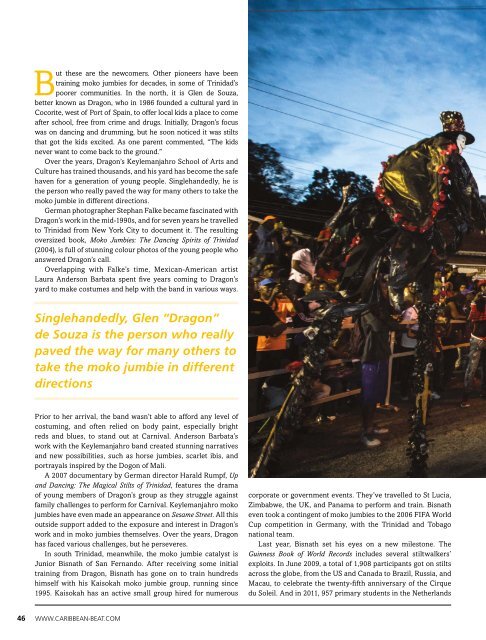Caribbean Beat — January/February 2018 (#149)
A calendar of events; music, film, and book reviews; travel features; people profiles, and much more.
A calendar of events; music, film, and book reviews; travel features; people profiles, and much more.
Create successful ePaper yourself
Turn your PDF publications into a flip-book with our unique Google optimized e-Paper software.
But these are the newcomers. Other pioneers have been<br />
training moko jumbies for decades, in some of Trinidad’s<br />
poorer communities. In the north, it is Glen de Souza,<br />
better known as Dragon, who in 1986 founded a cultural yard in<br />
Cocorite, west of Port of Spain, to offer local kids a place to come<br />
after school, free from crime and drugs. Initially, Dragon’s focus<br />
was on dancing and drumming, but he soon noticed it was stilts<br />
that got the kids excited. As one parent commented, “The kids<br />
never want to come back to the ground.”<br />
Over the years, Dragon’s Keylemanjahro School of Arts and<br />
Culture has trained thousands, and his yard has become the safe<br />
haven for a generation of young people. Singlehandedly, he is<br />
the person who really paved the way for many others to take the<br />
moko jumbie in different directions.<br />
German photographer Stephan Falke became fascinated with<br />
Dragon’s work in the mid-1990s, and for seven years he travelled<br />
to Trinidad from New York City to document it. The resulting<br />
oversized book, Moko Jumbies: The Dancing Spirits of Trinidad<br />
(2004), is full of stunning colour photos of the young people who<br />
answered Dragon’s call.<br />
Overlapping with Falke’s time, Mexican-American artist<br />
Laura Anderson Barbata spent five years coming to Dragon’s<br />
yard to make costumes and help with the band in various ways.<br />
Singlehandedly, Glen “Dragon”<br />
de Souza is the person who really<br />
paved the way for many others to<br />
take the moko jumbie in different<br />
directions<br />
Prior to her arrival, the band wasn’t able to afford any level of<br />
costuming, and often relied on body paint, especially bright<br />
reds and blues, to stand out at Carnival. Anderson Barbata’s<br />
work with the Keylemanjahro band created stunning narratives<br />
and new possibilities, such as horse jumbies, scarlet ibis, and<br />
portrayals inspired by the Dogon of Mali.<br />
A 2007 documentary by German director Harald Rumpf, Up<br />
and Dancing: The Magical Stilts of Trinidad, features the drama<br />
of young members of Dragon’s group as they struggle against<br />
family challenges to perform for Carnival. Keylemanjahro moko<br />
jumbies have even made an appearance on Sesame Street. All this<br />
outside support added to the exposure and interest in Dragon’s<br />
work and in moko jumbies themselves. Over the years, Dragon<br />
has faced various challenges, but he perseveres.<br />
In south Trinidad, meanwhile, the moko jumbie catalyst is<br />
Junior Bisnath of San Fernando. After receiving some initial<br />
training from Dragon, Bisnath has gone on to train hundreds<br />
himself with his Kaisokah moko jumbie group, running since<br />
1995. Kaisokah has an active small group hired for numerous<br />
corporate or government events. They’ve travelled to St Lucia,<br />
Zimbabwe, the UK, and Panama to perform and train. Bisnath<br />
even took a contingent of moko jumbies to the 2006 FIFA World<br />
Cup competition in Germany, with the Trinidad and Tobago<br />
national team.<br />
Last year, Bisnath set his eyes on a new milestone. The<br />
Guinness Book of World Records includes several stiltwalkers’<br />
exploits. In June 2009, a total of 1,908 participants got on stilts<br />
across the globe, from the US and Canada to Brazil, Russia, and<br />
Macau, to celebrate the twenty-fifth anniversary of the Cirque<br />
du Soleil. And in 2011, 957 primary students in the Netherlands<br />
46 WWW.CARIBBEAN-BEAT.COM


















